RV Refrigerator Not Cooling But Freezer Is: Troubleshooting
If you don’t know why your RV refrigerator not cooling but the freezer is, don’t worry. With more than 7 years of experience in the RV industry, I’m here to guide you. Read on as I’ll discuss the 6 common reasons behind this problem along with their fixes to get back the performance of RV refrigerators. Without any delay, let’s get started.
Table of Contents
Comparison Between Normal Refrigerators and RV Refrigerators
Have a look at this table where I have listed a quick overview of a normal refrigerator vs an RV refrigerator:
Parameters | Normal Refrigerator | RV Refrigerator |
Size: | Larger than RV Refrigerator | Smaller in size |
Cost: | Expensive | Less expensive than regular refrigerator |
Maintenance of Cooling System: | Use compressor to maintain cold temperatures | Uses ammonia, hydrogen gas, and water to maintain cold temperatures |
Capacity: | Large space availability | Smaller capacity |
Power Source: | Runs on AC power | Runs on propane, LP gas, or the RV’s battery |
Durability: | Not designed to withstand rough treatment and variable conditions | Designed to withstand the vibrations and movements of an RV |
Now we have gone through the basics, let’s revert to the RV refrigerator’s working, problems and their solutions:
4 Ways to Determine If RV Refrigerator Not Cooling But Freezer Is
Are you struggling to know whether your RV refrigerator is working fine or not? We are on the same page. A couple of months ago, I faced this issue when I was busy at road tripping on U.S. Route 66. After some troubleshooting, I reached the core reason for this problem.
However, I also found that plenty of RV owners face this trouble. Below are 4 ways to check if your RV refrigerator is working properly:
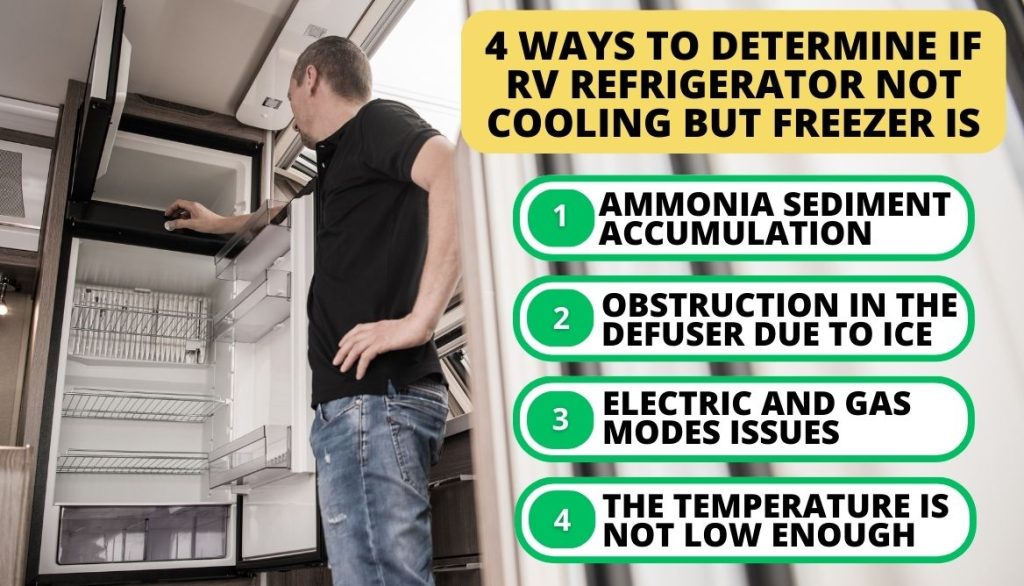
1. There is An Accumulation of Ammonia Sediment
Try to spot yellow residue or powder close to the burner or coolant unit which is an obvious sign of a serious problem. If there isn’t any such symptom, the refrigerator is probably working fine.
2. There is An Obstruction in the Defuser Due to Ice
The diffuser plays an essential role in facilitating the movement of cold air from the freezer into the refrigerator. If there is no blockage of ice in the diffuser, then your RV refrigerator is working properly.
3. The Problem with Electric and Gas Modes
RV refrigerators can work on both eclectic and gas modes. Here is how you can confirm if one mode is working and the other isn’t:
- To verify the electric mode: Turn on the switch and if the refrigerator temperature reaches 34° Fahrenheit, then the electrical mode is working fine.
- To verify gas mode: Turn on the burner that works on LP gas and ignite propane gas. If the refrigerator doesn’t reach the optimum temperature, this means the problem lies in the gas mode or with the burner/heating element.
4. The Temperature is Not Low Enough
This is probably the most proper way to spot whether the refrigerator is working fine or not. If the temperature is not in the optimum range of 43° Fahrenheit in the main compartment and 34°F in the refrigerator, the efficiency of the unit has decreased.
How To Fix RV Refrigerator Not Cooling But Freezer Is
Here I’ll thoroughly explain the 6 most common problems of your RV refrigerator not cooling but the freezer is, along with their fixes. Let’s begin!
1. Air Circulation Problems
Inadequate air circulation is one of the common issues in extremely hot regions. Your RV refrigerator may find it challenging to produce the desired chilling effect if hydrogen and ammonia burn more slowly than the rate at which the surrounding air heats up.
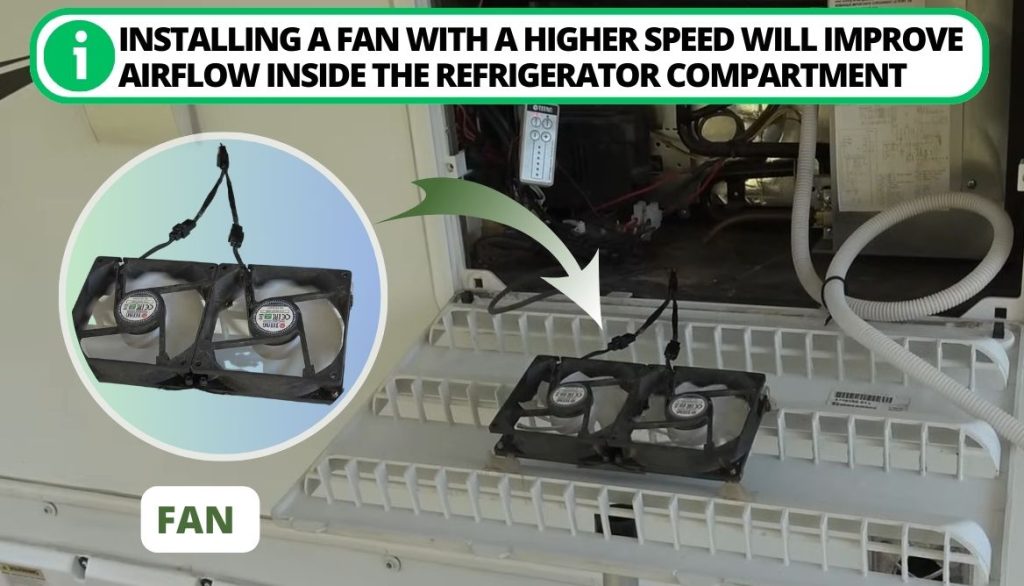
You can fix this issue by installing a fan with a higher RPM (revolutions per minute) and placing it near the back of your RV refrigerator opening. This improves airflow inside the refrigerator’s compartment and creates a balanced relationship between the temperature inside the refrigerator and outside air.
My recommendation: I recommend you use TITAN- 12V/ 24V DC fan. This is a portable fan with a low noise level and can fit any compartment.
2. Issues with Temperature Sensors
Sometimes, the culprit behind your RV refrigerator failure could be the faulty temperature sensor. The sensors can move, slip, and even tumble out of place if only weakly attached.
To solve this problem, make sure these sensors are attached to the fin correctly on both sides. Once the sensor is firmly attached, you can move it to and fro to change your RV refrigerator’s temperature.

Important note: If tweaking the refrigerator thermometer is still not solving this issue, you can buy a new unit such as the Govee Hygrometer Thermometer. This device can even be controlled remotely via an app and displays real-time data.
3. Faulty Thermistor
A thermistor is an essential part of an RV refrigerator which controls the temperature significantly. It has a negative temperature coefficient that impacts the cooling capability of the refrigerator compartment.
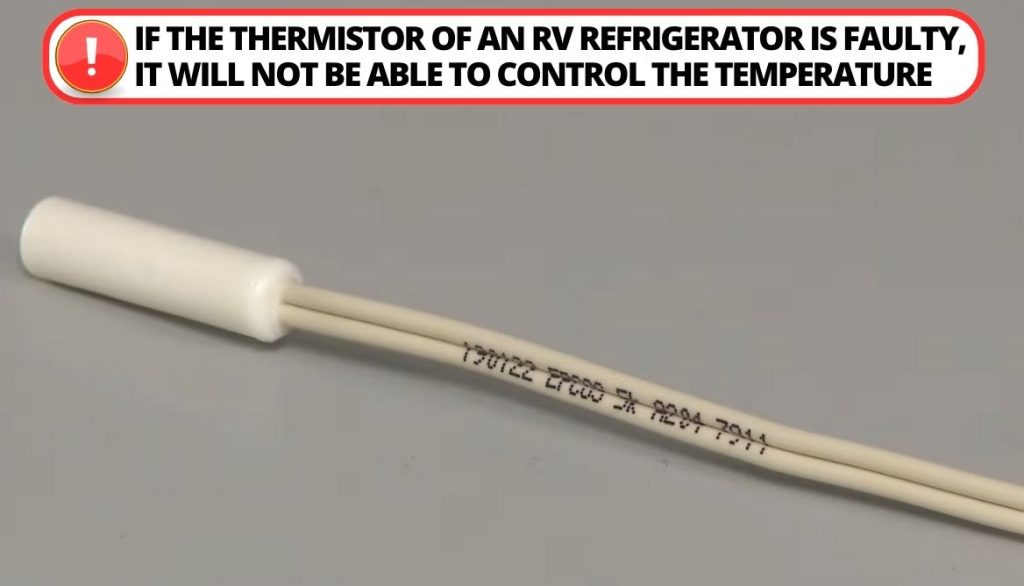
However, if the thermistor of your RV refrigerator is malfunctioning, it will fail to control temperature. Hence, there are chances that the refrigerator will take more time to produce cooling.
The simplest way to fix this issue is to unplug the thermistor and replace it with a new one like the sixcow Thermistor. This will improve the efficiency of your RV refrigerator and avoid interference with temperature control.
Pro Tip: It’s best to avoid using your RV refrigerator for an extended amount of time without a thermistor since it could harm the refrigerator.
4. The Refrigerator Exhaust is Blocked
The exhaust in your refrigerator removes the hot air. In case, if it is blocked due to any dust or debris, the hot air will start gathering in the refrigerator. As a result, the refrigerator will start losing to produce cooling. You can find the refrigerator’s ventilator on the back of the unit, exiting via the upper refrigerator vent cover.
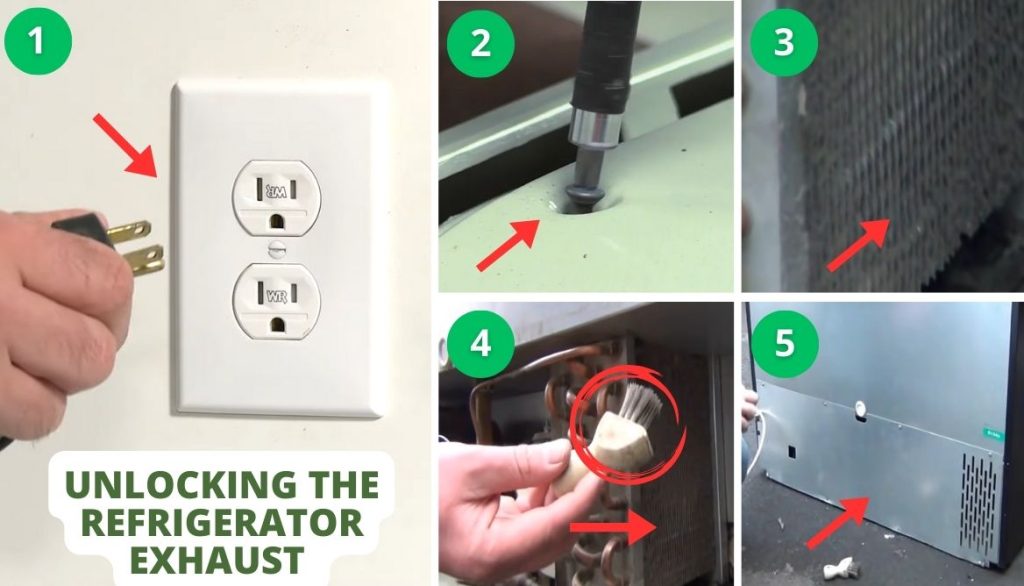
To cater to this problem, you just have to follow these simple 5 steps:
- Step 1: Start by turning off your RV fridge by unplugging it from a power source.
- Step 2: Remove the vent cover by using a screwdriver.
- Step 3: Check the vent cover for obstructions preventing hot air from exiting.
- Step 4: Use a soft brush or hoover to clear every blockage you encounter.
- Step 5: After cleaning, fix the vent cover by screwing it back into place.
5. Fridge Coolant
Coolant/refrigerant is necessary for an RV refrigerator to operate correctly. It is usually a heated mixture of ammonia gas that is circulating to the freezer compartment and in the refrigerator section. That’s why, cooling problems with your RV refrigerator typically occur in the refrigerator area more often as the gas may not often reach it.
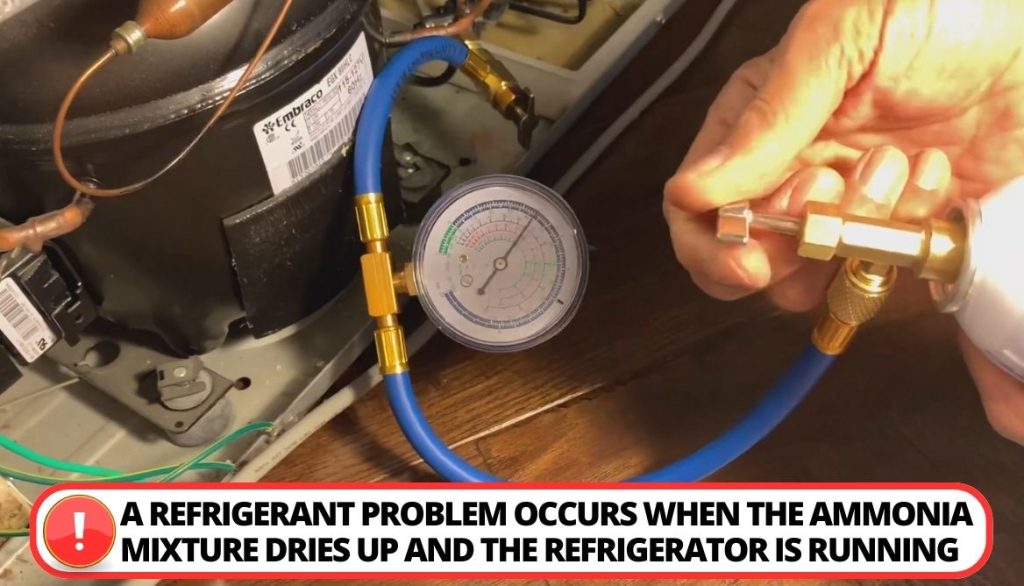
However, the issue with the refrigerant typically occurs when the ammonia mixture dries out and your refrigerator keeps running on an empty tank.
The problem can be fixed by refilling your coolant tank with an ammonia mixture. Be sure the fridge is defrosted before you fill-up the tank. If the refrigerator stays frozen during this operation, foul smells will develop in the chamber.
Point to remember: Make sure not to use your RV refrigerator when the tank is empty and keep it turned off. Moreover, take the help of an expert before filling the refrigerant.
6. Unequal Surfaces
It is challenging to guarantee ammonia’s quick and unobstructed passage to the chamber as it is denser than water, which makes it flow more slowly.
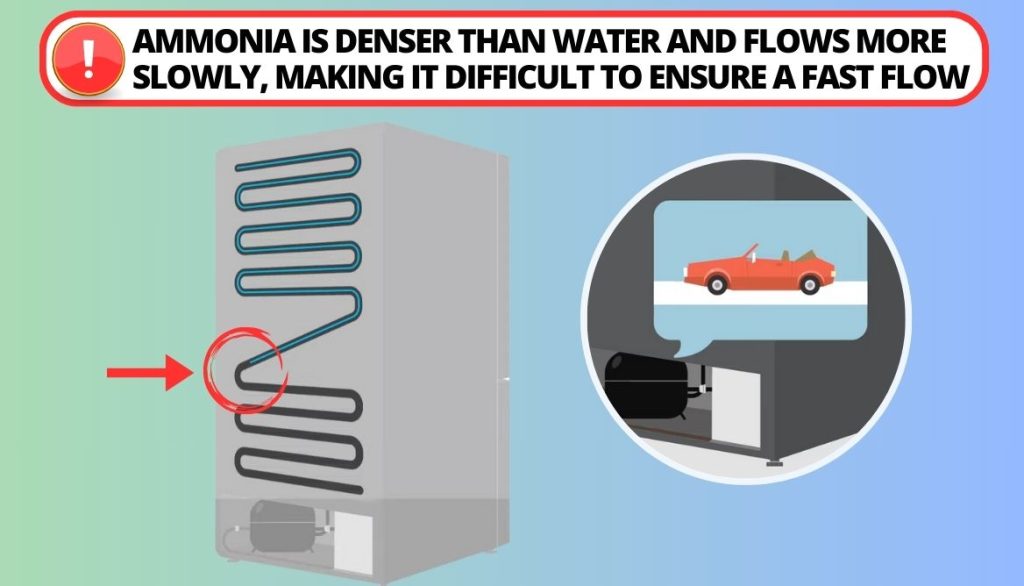
Therefore, when you are driving over uneven roads, the combination proportions can be thrown off, which reduces the chilling effectiveness of your RV refrigerator. This imbalance frequently clarifies why the refrigerator struggles to maintain ideal temperatures while the freezer compartment stays cold.
The following solutions can help you in this regard:
- Maintain your freezer and refrigerator upright or at an angle of no more than 6 degrees.
- Use gravity to maintain a balance between the freezer and refrigerator. In simple words, it means that if the refrigerator and fridge are not in balance, it will affect cooling efficiency.
What is the Optimal Temperature Range for an RV Refrigerator?
The optimal temperature range for an RV refrigerator is around 34 degrees Fahrenheit, and the freezer should be around zero degrees. Moreover, like any other refrigerator, the main compartment of your RV refrigerator shouldn’t go any higher than 42 degrees. A little more than or less than 3 degrees can be tolerated in this temperature range.
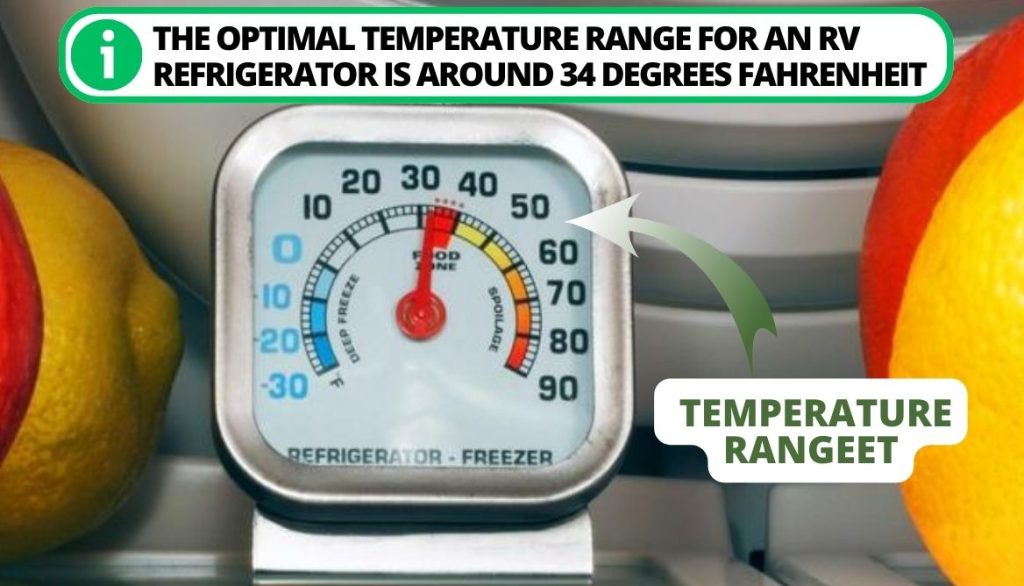
Maintaining Your RV Fridge: 9 Useful Tips for Optimal Performance
Listed below are the important guidelines to maintain your RV in shape and ensure its optimal performance:
- Park on level ground: Make sure your RV is level when parked to avoid the refrigerator having to work harder than it has to.
- Keep it clean: Keep your RV refrigerator clean and clear of dirt and debris by giving it regular inspections.
- Do not put hot food inside: Avoid putting hot food inside the refrigerator as this may raise the internal temperature.
- Always keep the door shut: Ensure that the refrigerator door is correctly closed at all times to stop cold air from escaping.
- Defrost from time to time or when needed: Defrost your RV refrigerator when there’s noticeable ice accumulation or it’s been a while since you’ve defrosted it.
- Install a small battery-operated fan: Placing a small battery-operated evaporator fan in your RV refrigerator can help maintain a constant temperature and enhance airflow.
- Monitor the temperature: Keep an eye on the temperature of your RV refrigerator and adjust it as per your needs.
- Climate control optimization: Try to turn off the climate control switch. By doing this, your RV refrigerator’s overall efficiency will increase.
- Monitoring of Propane Pressure: To ensure peak performance, always have a manometer on standby for precise propane pressure monitoring.
FAQs
How do I reset my RV refrigerator?
You can reset your RV refrigerator by unplugging it for five minutes and then plugging it back in. If problems continue, refer to the manufacturer’s manual for detailed instructions.
Why is my Domestic RV refrigerator not getting cold enough?
If your domestic RV refrigerator isn’t getting cold enough, it could be due to a broken thermostat or inadequate ventilation around the cooling unit.
How do you clean RV refrigerator fins?
To clean your RV refrigerator fins, use a brush or vacuum cleaner to remove dust and debris. For safety reasons, make sure the refrigerator is off before cleaning.
Why is my RV refrigerator not cooling but the freezer is?
If your RV refrigerator is not cooling but the freezer is, you might have airflow issues. The diffuser that circulates cold air from the freezer into the refrigerator may have become clogged with ice.
Conclusion
The final say is that you should cater to problems related to RV refrigerator not cooling but freezer is quick. These can boost your RV experience in a much more engaging way.
For example, you should install an evaporator fan with greater RPM if there is a lack of air circulation in your RV refrigerator. Similarly, to increase the working efficiency of your RV fridge, make sure the voltage in your RV doesn’t go below 110 volts.
If you are still unable to resolve the RV refrigerator’s cooling problems on your own, I strongly advise hiring an expert to diagnose and fix these issues.
Nevertheless, have you faced any issues regarding the RV refrigerator’s cooling and how did you solve them? Share your experience with me in the comments below.

I`m a current Law Enforcement Officer working within the Counterterrorism Bureau in New York State. I have been Camping for over 20 years. My styles of camping include tent, car, truck, van, and RV travel trailer. I have a YouTube channel where I teach all types of camping with an entertaining method: https://youtube.com/@TheSmallsRVAdventures






